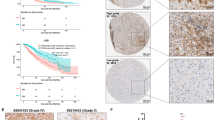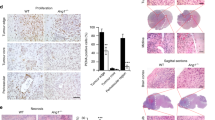Abstract
Invasive tumors, including gliomas, utilize proteinases to degrade extracellular matrix components and diffuse into the adjacent tissues or migrate toward distant ones. In addition, proteinase activity is required for the formation of new blood vessels within the tumor. Levels of the proteinase matrix metalloproteinase-2 (MMP-2) are highly increased in gliomas. In this study, we examined the effect of the downregulation of MMP-2 via adenovirus-mediated siRNA in gliomas. Here, we show that siRNA delivery significantly decreased levels of MMP-2 in the glioblastoma cell lines U-87 and U-251. U-87 and U-251 cells showed impaired invasion through matrigel as well as decreased migration from tumor spheroids transfected with adenoviral vector expressing siRNA against MMP-2. Additionally, tumor-induced angiogenesis was decreased in in vitro experiments in cultured human microvascular endothelial cells (HMECs) in serum-free conditioned medium of glioblastoma cells transfected with these constructs and co-cultures of glioma cells with HMECs. We also observed decreased angiogenesis in the in vivo dorsal skin-fold chamber model. Moreover, MMP-2 inhibition induced apoptotic cell death in vitro, and suppressed tumor growth of preestablished U-251 intracranial xenografts in nude mice. Thus, specific targeting of MMP-2 may provide a novel, efficient approach for the treatment of gliomas and improve the poor outcomes of patients with these brain tumors.
This is a preview of subscription content, access via your institution
Access options
Subscribe to this journal
Receive 50 print issues and online access
$259.00 per year
only $5.18 per issue
Buy this article
- Purchase on Springer Link
- Instant access to full article PDF
Prices may be subject to local taxes which are calculated during checkout





Similar content being viewed by others
References
Abe T, Mori T, Kohno K, Seiki M, Hayakawa T, Welgus HG et al. (1994). Expression of 72 kDa type IV collagenase and invasion activity of human glioma cells. Clin Exp Metastasis 12: 296–304.
Belotti D, Paganoni P, Manenti L, Garofalo A, Marchini S, Taraboletti G et al. (2003). Matrix metalloproteinases (MMP9 and MMP2) induce the release of vascular endothelial growth factor (VEGF) by ovarian carcinoma cells: implications for ascites formation. Cancer Res 63: 5224–5229.
Benelli R, Adatia R, Ensoli B, Stetler-Stevenson WG, Santi L, Albini A . (1994). Inhibition of AIDS-Kaposi's sarcoma cell induced endothelial cell invasion by TIMP-2 and a synthetic peptide from the metalloproteinase propeptide: implications for an anti-angiogenic therapy. Oncol Res 6: 251–257.
Castro MG, Cowen R, Williamson IK, David A, Jimenez-Dalmaroni MJ, Yuan X et al. (2003). Current and future strategies for the treatment of malignant brain tumors. Pharmacol Ther 98: 71–108.
Chambers AF, Matrisian LM . (1997). Changing views of the role of matrix metalloproteinases in metastasis. J Natl Cancer Inst 89: 1260–1270.
Chetty C, Bhoopathi P, Joseph P, Chittivelu S, Rao JS, Lakka SS . (2006). Adenovirus-mediated siRNA against MMP-2 suppresses tumor growth and lung metastasis in mice. Mol Cancer Ther 5: 2289–2299.
Coussens LM, Fingleton B, Matrisian LM . (2002). Matrix metalloproteinase inhibitors and cancer: trials and tribulations. Science 295: 2387–2392.
Deryugina EI, Bourdon MA, Reisfeld RA, Strongin A . (1998). Remodeling of collagen matrix by human tumor cells requires activation and cell surface association of matrix metalloproteinase-2. Cancer Res 58: 3743–3750.
Deryugina EI, Soroceanu L, Strongin AY . (2002). Up-regulation of vascular endothelial growth factor by membrane-type 1 matrix metalloproteinase stimulates human glioma xenograft growth and angiogenesis. Cancer Res 62: 580–588.
Egeblad M, Werb Z . (2002). New functions for the matrix metalloproteinases in cancer progression. Nat Rev Cancer 2: 161–174.
Fang J, Shing Y, Wiederschain D, Yan L, Butterfield C, Jackson G et al. (2000). Matrix metalloproteinase-2 is required for the switch to the angiogenic phenotype in a tumor model. Proc Natl Acad Sci USA 97: 3884–3889.
Folgueras AR, Pendas AM, Sanchez LM, Lopez-Otin C . (2004). Matrix metalloproteinases in cancer: from new functions to improved inhibition strategies. Int J Dev Biol 48: 411–424.
Folkman J . (1990). What is the evidence that tumors are angiogenesis dependent? J Natl Cancer Inst 82: 4–6.
Forsyth PA, Wong H, Laing TD, Rewcastle NB, Morris DG, Muzik H et al. (1999). Gelatinase-A (MMP-2), gelatinase-B (MMP-9) and membrane type matrix metalloproteinase-1 (MT1-MMP) are involved in different aspects of the pathophysiology of malignant gliomas. Br J Cancer 79: 1828–1835.
Fowlkes JL, Enghild JJ, Suzuki K, Nagase H . (1994). Matrix metalloproteinases degrade insulin-like growth factor-binding protein-3 in dermal fibroblast cultures. J Biol Chem 269: 25742–25746.
Giannelli G, Falk-Marzillier J, Schiraldi O, Stetler-Stevenson WG, Quaranta V . (1997). Induction of cell migration by matrix metalloprotease-2 cleavage of laminin-5. Science 277: 225–228.
Giese A, Westphal M . (1996). Glioma invasion in the central nervous system. Neurosurgery 39: 235–250.
Goldbrunner RH, Bernstein JJ, Tonn JC . (1999). Cell-extracellular matrix interaction in glioma invasion. Acta Neurochir (Wien) 141: 295–305.
Gondi CS, Lakka SS, Dinh D, Olivero W, Gujrati M, Rao JS . (2004a). Downregulation of uPA, uPAR and MMP-9 using small, interfering, hairpin RNA (siRNA) inhibits glioma cell invasion, angiogenesis and tumor growth. Neuron Glia Biol 1: 165–176.
Gondi CS, Lakka SS, Dinh DH, Olivero WC, Gujrati M, Rao JS . (2004b). RNAi-mediated inhibition of cathepsin B and uPAR leads to decreased cell invasion, angiogenesis and tumor growth in gliomas. Oncogene 23: 8486–8496.
Itoh T, Tanioka M, Yoshida H, Yoshioka T, Nishimoto H, Itohara S . (1998). Reduced angiogenesis and tumor progression in gelatinase A-deficient mice. Cancer Res 58: 1048–1051.
Kaliski A, Maggiorella L, Cengel KA, Mathe D, Rouffiac V, Opolon P et al. (2005). Angiogenesis and tumor growth inhibition by a matrix metalloproteinase inhibitor targeting radiation-induced invasion. Mol Cancer Ther 4: 1717–1728.
Komatsu K, Nakanishi Y, Nemoto N, Hori T, Sawada T, Kobayashi M . (2004). Expression and quantitative analysis of matrix metalloproteinase-2 and -9 in human gliomas. Brain Tumor Pathol 21: 105–112.
Lakka SS, Gondi CS, Dinh DH, Olivero WC, Gujrati M, Rao VH et al. (2005a). Specific interference of uPAR and MMP-9 gene expression induced by double-stranded RNA results in decreased invasion, tumor growth and angiogenesis in gliomas. J Biol Chem 280: 21882–21892.
Lakka SS, Gondi CS, Rao JS . (2005b). Proteases and glioma angiogenesis. Brain Pathol 15: 327–341.
Lakka SS, Rajan M, Gondi CS, Yanamandra N, Chandrasekar N, Jasti SL et al. (2002). Adenovirus-mediated expression of antisense MMP-9 in glioma cells inhibits tumor growth and invasion. Oncogene 21: 8011–8019.
Lal S, Lacroix M, Tofilon P, Fuller GN, Sawaya R, Lang FF . (2000). An implantable guide-screw system for brain tumor studies in small animals. J Neurosurg 92: 326–333.
Levi E, Fridman R, Miao HQ, Ma YS, Yayon A, Vlodavsky I . (1996). Matrix metalloproteinase 2 releases active soluble ectodomain of fibroblast growth factor receptor 1. Proc Natl Acad Sci USA 93: 7069–7074.
McCaffrey AP, Meuse L, Pham TT, Conklin DS, Hannon GJ, Kay MA . (2002). RNA interference in adult mice. Nature 418: 38–39.
Murphy AN, Unsworth EJ, Stetler-Stevenson WG . (1993). Tissue inhibitor of metalloproteinases-2 inhibits bFGF-induced human microvascular endothelial cell proliferation. J Cell Physiol 157: 351–358.
Nakao-Hayashi J, Ito H, Kanayasu T, Morita I, Murota S . (1992). Stimulatory effects of insulin and insulin-like growth factor I on migration and tube formation by vascular endothelial cells. Atherosclerosis 92: 141–149.
Park CM, Park MJ, Kwak HJ, Lee HC, Kim MS, Lee SH et al. (2006). Ionizing radiation enhances matrix metalloproteinase-2 secretion and invasion of glioma cells through Src/epidermal growth factor receptor-mediated p38/Akt and phosphatidylinositol 3-kinase/Akt signaling pathways. Cancer Res 66: 8511–8519.
Rao JS . (2003). Molecular mechanisms of glioma invasiveness: the role of proteases. Nat Rev Cancer 3: 489–501.
Ray JM, Stetler-Stevenson WG . (1994). The role of matrix metalloproteases and their inhibitors in tumour invasion, metastasis and angiogenesis. Eur Respir J 7: 2062–2072.
Rosenberg GA . (1995). Matrix metalloproteinases in brain injury. J Neurotrauma 12: 833–842.
Sawaya R, Go Y, Kyritsis AP, Uhm J, Venkaiah B, Mohanam S et al. (1998). Elevated levels of Mr 92,000 type IV collagenase during tumor growth in vivo. Biochem Biophys Res Commun 251: 632–636.
Sawaya RE, Yamamoto M, Gokaslan ZL, Wang SW, Mohanam S, Fuller GN et al. (1996). Expression and localization of 72 kDa type IV collagenase (MMP-2) in human malignant gliomas in vivo. Clin Exp Metastasis 14: 35–42.
Stetler-Stevenson WG . (1990). Type IV collagenases in tumor invasion and metastasis. Cancer Metastasis Rev 9: 289–303.
Stetler-Stevenson WG . (1999). Matrix metalloproteinases in angiogenesis: a moving target for therapeutic intervention. J Clin Invest 103: 1237–1241.
Wang M, Wang T, Liu S, Yoshida D, Teramoto A . (2003). The expression of matrix metalloproteinase-2 and -9 in human gliomas of different pathological grades. Brain Tumor Pathol 20: 65–72.
Wild-Bode C, Weller M, Rimner A, Dichgans J, Wick W . (2001). Sublethal irradiation promotes migration and invasiveness of glioma cells: implications for radiotherapy of human glioblastoma. Cancer Res 61: 2744–2750.
Woessner Jr JF, Gunja-Smith Z . (1991). Role of metalloproteinases in human osteoarthritis. J Rheumatol Suppl 27: 99–101.
Xia H, Mao Q, Paulson HL, Davidson BL . (2002). siRNA-mediated gene silencing in vitro and in vivo. Nat Biotechnol 20: 1006–1010.
Acknowledgements
We thank Shellee Abraham for preparing the article and Diana Meister and Sushma Jasti for the review. We also thank Noorjehan Ali for technical assistance. This research was supported by National Cancer Institute grants CA 75557, CA 92393, CA 95058, CA 116708, NINDS NS 47699, NS57529, NS61835, and Caterpillar Inc., OSF St Francis Inc., Peoria, IL (to JSR).
Author information
Authors and Affiliations
Corresponding author
Additional information
Supplementary Information accompanies the paper on the Oncogene website (http://www.nature.com/onc).
Supplementary information
Rights and permissions
About this article
Cite this article
Kargiotis, O., Chetty, C., Gondi, C. et al. Adenovirus-mediated transfer of siRNA against MMP-2 mRNA results in impaired invasion and tumor-induced angiogenesis, induces apoptosis in vitro and inhibits tumor growth in vivo in glioblastoma. Oncogene 27, 4830–4840 (2008). https://doi.org/10.1038/onc.2008.122
Received:
Revised:
Accepted:
Published:
Issue Date:
DOI: https://doi.org/10.1038/onc.2008.122
Keywords
This article is cited by
-
Circ_0000620 acts as an oncogenic factor in gastric cancer through regulating MMP2 expression via sponging miR-671-5p
Journal of Biological Research-Thessaloniki (2021)
-
Nicotine increased VEGF and MMP2 levels in the rat eye and kidney
Environmental Science and Pollution Research (2019)
-
Paeoniflorin Inhibits Migration and Invasion of Human Glioblastoma Cells via Suppression Transforming Growth Factor β-Induced Epithelial–Mesenchymal Transition
Neurochemical Research (2018)
-
RUNX1 Regulates Migration, Invasion, and Angiogenesis via p38 MAPK Pathway in Human Glioblastoma
Cellular and Molecular Neurobiology (2017)
-
In vivo optical imaging of MMP2 immuno protein antibody: tumor uptake is associated with MMP2 activity
Scientific Reports (2016)



